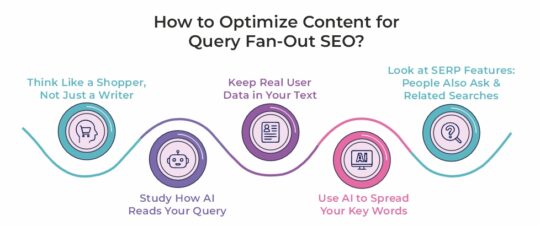Google, yes, is the favorite search engine for us all. But have you noticed the continuous changes happening in Google’s interface, functionality, and more?
Well, most of you might be! Yes, and one such upgrade in Google search is the AI overview, which gives summaries of what you’re looking for. Enter the query, and you get a summary of the answer you need without clicking on a single website link.
Yes! This is surreal. Alongside, you also might have noticed the option to switch to “AI Mode.” Everything is said now. But do you know the exact reason behind what’s happening in the Google Search Engine?
Here comes the strategic technique known as the Query Fan Out Technique. It's the whole and sole cornerstone for Google’s latest AI Overviews and AI Mode innovations.
But do you know what 'query-fan-out' means exactly? Dive into the blog and clear up your concept.
Explaining What the Query Fan Out Technique in Google Search
Let’s understand the concept in simple words.
Query fan-out is a method where the AI breaks a user's search query into multiple subqueries. Each query targets a particular context, intent, or entity. It then searches for information from various sources, such as documents and blogs, for each subquery to provide a detailed answer to the initial query.
The query fan-out technique is used in both Google’s AI Mode and AI Overviews, but it isn’t applied to simple queries that only need direct answers.
To explain the query decomposition in simple words, let’s check out the example below:
“Suppose you have a complicated medical condition, and you go to the hospital. Instead of relying on a single doctor, you are advised to consult specialists such as a psychologist, a dietitian, and others. Every doctor shares their suggestions, and then the final diagnosis of the disease is made.”
These models do not simply fetch information; instead, they facilitate comparison, reasoning, and a clear understanding of the concept.
Importance of this Technique
The new approach lets AI Mode access a large amount of information from the web. Considering all, it gives precise and in-depth information that would be difficult to get with single searches. Google makes searching easy and practical by performing multiple searches and providing accurate information. This type of method is ideal for queries that require in-depth reasoning and comparisons.
How to Optimize Content for Query Fan-Out SEO?
SEO isn't just about one keyword now — it's about matching how Google's AI spreads a search into many user goals. This is known as Query Fan-Out Mode.
Now, Google doesn't just give one answer. It tries to guess all the questions a user might ask next. If your text doesn't look at those points, you'll lose out on being seen in AI Overviews, Top Snippets, and People Also Ask results.
Here's how to improve your content for query fan-out and increase your visibility in search results.
1. Think Like a Shopper, Not Just a Writer
Query fan-out illustrates the steps buyers take when they decide to make a purchase.
Consider other questions they might ask after the main keyword.
Use the keyword “best running shoes for flat feet.” A buyer might also want to know:
-
- What kind of arch support is best for flat feet?
- Which brands are suggested by foot doctors?
- Do they have lower knee, hip, or back pain?
- How to check if you have a flat foot?
When you put answers to these smaller questions in your text (with clear H2/H3 headings), you hit more user goals. This significantly increases your chances of appearing in AI results and the "People Also Ask" boxes.
2. Study How AI Reads Your Query
To improve your fan-out skills, learn how Google's Gemini AI model distributes queries.
Here's how:
Does it put products by features? Does it highlight the good/bad points or provide comparisons? Copy that setup in your piece.
Check Gemini’s Thoughts (via AI Studio): Don’t just read the AI’s answer, see how it thinks. What more questions does it make? What points does it think are key? Let these ideas shape your content plan.
3. Keep Real User Data in Your Text
Look in AI Overviews: Use your keyword and discover how Google arranges results. One keyword isn't enough now. You need many related words and trending searches that relate to your central theme.
Tools that help: AnswerThePublic / Also Asked: Great for finding real questions (what, why, how, which).
Google Trends: See rising searches and seasonal changes. For example, if your topic is “vegan diets", related searches like “quinoa recipes” or “Galveston diet” can make your piece fuller and deeper.
This kind of depth shows that you know a lot about Google, helping your chances of ranking for many long queries.
4. Use AI to Spread Your Key Words
AI tools like ChatGPT or Perplexity can help spread your queries.
Please help me spread the query [keyword]. Make related questions, comparisons, and subtopics sorted by how they fit."
For example, if your starting query is “vegan diet benefits”, AI might spread it into
-
- Nutrient details (protein, B12, calcium)
- Weight loss odds
- Vegan vs. vegetarian diet match-up
- Common slip-ups newbies make
- Needed supplements for vegans
5. Look at SERP Features: People Also Ask & Related Searches
Google already shows what users ask next. You need to read into it deeply.
People Also Ask (PAA): These questions show the exact fan-out process.
If you see a question, come up with many keywords, it’s a needed section in your text.
Related Searches (bottom of SERP): Shows you more searches that users often investigate. Use these to make more blog posts or links inside your site.
How Query Fan-Out Affects SEO Rankings?
The query fan-out plan has changed how search ranks work. Previously, creating content based on keywords helped improve the ranking of your content. However, with AI’s deeper examination of context, goals, and follow-up questions, the helpfulness of your content has a significant impact on search rankings.
AI breaks down the single query into multiple related questions. Therefore, a text that provides a comprehensive and in-depth look at the topic is more likely to appear in results.
Some Practical Examples of Query Fan Out Technique
Suppose a user asks AI Mode: “What are some of the protein-rich foods you can share a few”? AI can break this query into multiple sub-queries and share a detailed answer.
Let’s look at some of the queries:
-
- Benefits of protein-rich food
- What role does protein play in the body
- What are the downsides of not consuming enough protein?
The work is simple. AI searches for information for each sub-query and then presents a detailed answer.
Wrapping it Up
So, we have reached the end of the Query Fan out blog. As we now have a clear idea of how this technique helps generate responses that meet the user’s satisfaction by answering what’s required and anticipating questions that may arise next.
Key Points for Getting Better at Query Fan-Out
-
- Start with a keyword but map the path: Think of doubts, matches, and next-step questions.
- Follow AI thinking: Look at AI Overviews and Gemini’s thought ways to match how queries spread.
- Build a deep theme: Make use of tools such as AnswerThePublic and Google Trends to identify questions and subtopics.
- Use AI to spread queries: Make your text groups bigger with ChatGPT or Perplexity.
That’s a wrap!
Frequently Asked Questions
Q1: What is a Query Fan Out?
Ans: Query fan out is basically a technique used by Google to split a single query into a number of several sub queries.
Q2: Why is Query Fan Out important for SEO?
Ans: The Query Fan-Out process lets Google’s AI guess any follow-up questions that users want to ask. When the content you create is optimized to answer these questions, you can rank better in the AI overviews, Page Also Ask, Featured Snippets and more.
Recommended For You:
Google Gemini Image-to-Video with Veo 3: How to Turn Photos into Videos in 3 Steps





